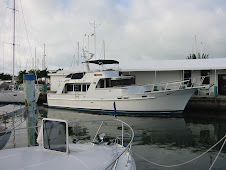The distance of 185 miles is too much to be made in daylight hours this time of year. So, many boaters depart in the afternoon, go throughout the night, and arrive in the morning of the following day. It is important to transit the coastal area at the beginning and end of the journey in daylight, as the crabbers have their crab traps scattered at random in 30 feet of water or less on each coast. These traps have lines that can become entangled in propellers and shafts, causing big problems for boaters!
 So, with favorable, moderate seas predicted for the night of November 23, Monarch and nine other boats decided to make the crossing. We got a taste of night navigational lighting the evening before our departure, as Buddy’s Boys shrimp boat went out for an overnight run – all lit up.
So, with favorable, moderate seas predicted for the night of November 23, Monarch and nine other boats decided to make the crossing. We got a taste of night navigational lighting the evening before our departure, as Buddy’s Boys shrimp boat went out for an overnight run – all lit up. And as we departed at 12:30 p.m. on November 23, we felt it was a good luck sign to see the Miss Martha, a shrimper offloading her catch.
And as we departed at 12:30 p.m. on November 23, we felt it was a good luck sign to see the Miss Martha, a shrimper offloading her catch. Apalachicola Bay was calm, wide and shallow, but well buoyed, and we had other good luck signs of loons and dolphins playing in our wake. We were ready for the big crossing.
Apalachicola Bay was calm, wide and shallow, but well buoyed, and we had other good luck signs of loons and dolphins playing in our wake. We were ready for the big crossing. The Government Cut pass into the Gulf was well marked and easily navigated.
The Government Cut pass into the Gulf was well marked and easily navigated. St. George Island is the barrier island that separates Apalachicola Bay from the Gulf. It is heavily built up with homes, much more so than Apalachicola.
St. George Island is the barrier island that separates Apalachicola Bay from the Gulf. It is heavily built up with homes, much more so than Apalachicola. As the sun set, the clouds came in, and the winds were at direct opposition to the 3-4 foot seas. The ride was lumpy and bumpy, and the pitch-black night fell. We were glad for our GPS, our computer charts and navigation, and our old-fashioned back up paper charts and 30-minute dead reckoning fixes. And we could see the navigation lights of our fellow boaters headed the same way, and talk to them on the radio. The two of us on Monarch took turns standing watch and trying to catch a quick nap.
As the sun set, the clouds came in, and the winds were at direct opposition to the 3-4 foot seas. The ride was lumpy and bumpy, and the pitch-black night fell. We were glad for our GPS, our computer charts and navigation, and our old-fashioned back up paper charts and 30-minute dead reckoning fixes. And we could see the navigation lights of our fellow boaters headed the same way, and talk to them on the radio. The two of us on Monarch took turns standing watch and trying to catch a quick nap.


No comments:
Post a Comment